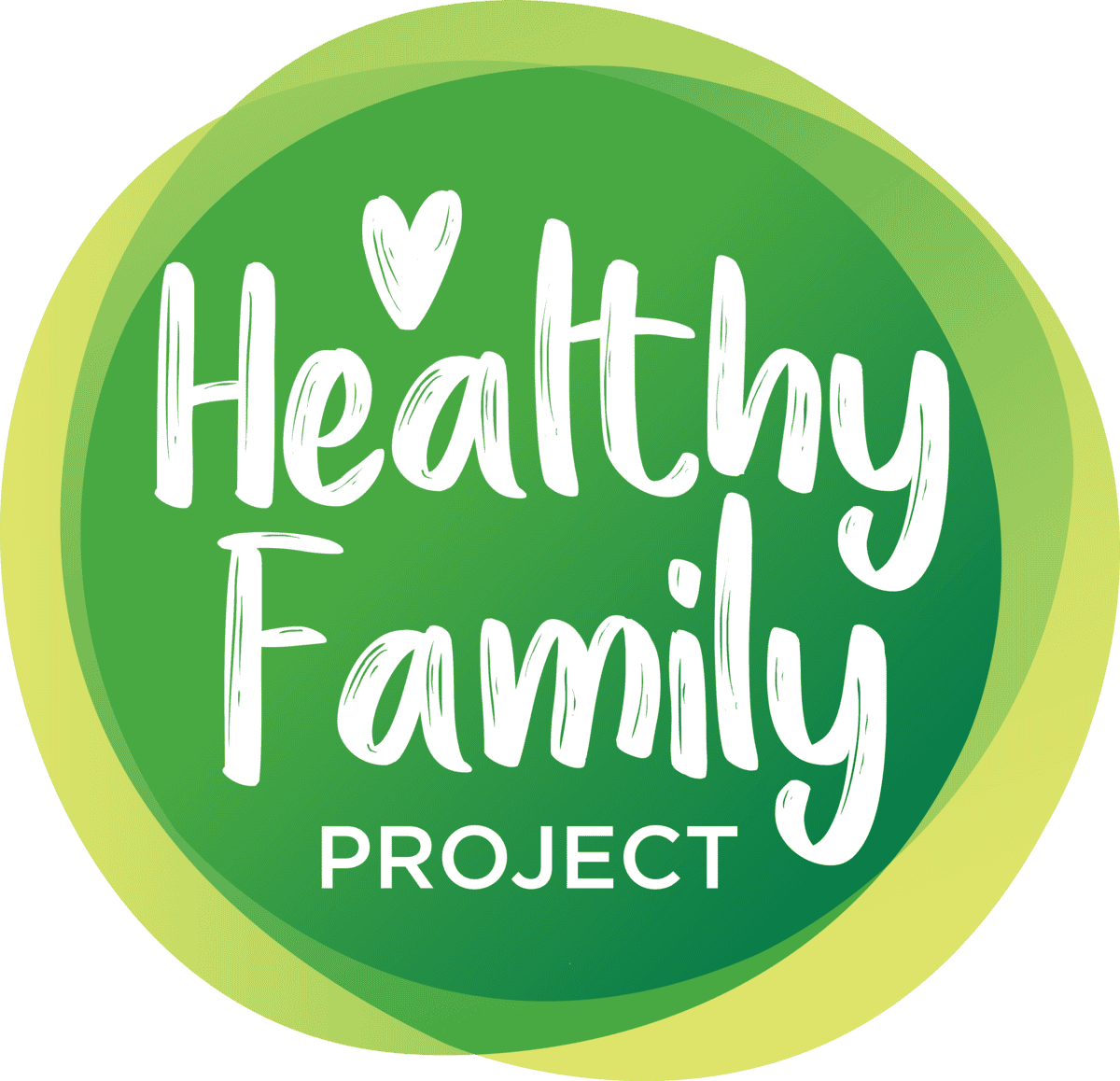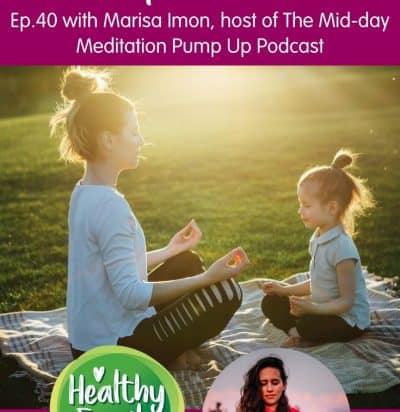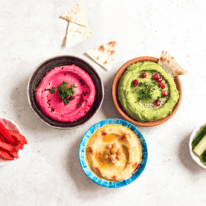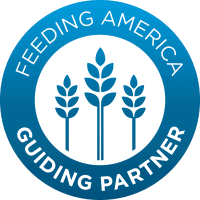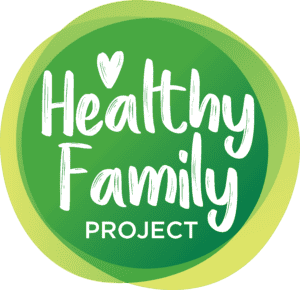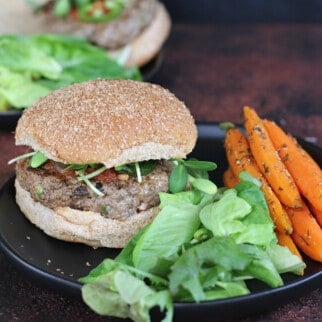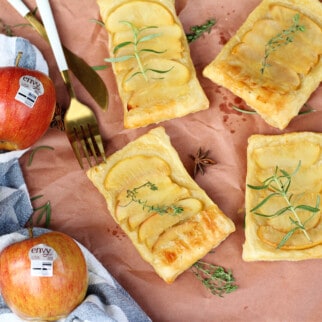Holiday Replay: Meditation Benefits for Kids
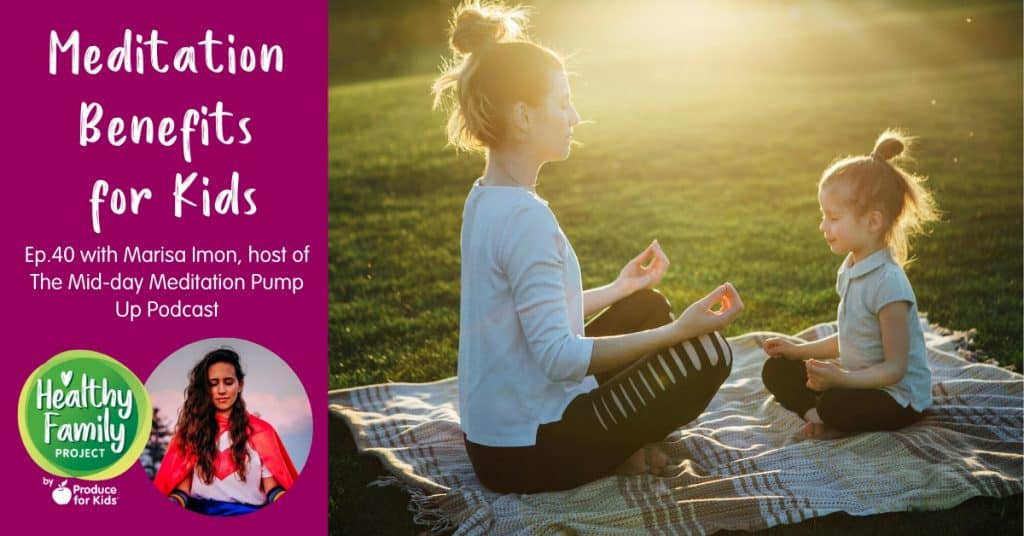
In this episode of Healthy Family Project, we talk to Marisa Imon, author and host of the Mid-day Meditation Pump Up podcast. Marisa defines meditation and shares the many benefits for adults and children, along with ways to easily fit meditation into our busy schedules.
Marisa is a former teacher and also a best-selling author of the book Super-Intense: How Working with Your Emotional Intensity Makes you a Total Superhero, a meditation-creator, and comedic motivational speaker with training in positive youth development. She has created hundreds of meditations for various apps and business across the globe, serving clients across 14 countries.
She lives with Bipolar Type 1 and promotes the mindfulness practices that have positively supported her in living with her diagnosis. She believes that sharing experiences and creating safe spaces for open dialogue around mental illness can help combat stigma.
With thirteen years of experience working with youth and families of various backgrounds in the out-of-school time field, she enjoys sharing the mindfulness techniques in ways that can be easily implemented by everyone.
Listener Survey!
Thank you so much for supporting the Healthy Family Project Podcast! We’d love it if you could take 5 minutes to let us know how we can bring you the best possible content for future episodes. Take the survey here.
Healthy Recipes & Tips in Your Inbox
Sign up for the Healthy Family Project e-newsletter to receive healthy recipe inspiration, our latest blog posts and more directly to your inbox each week.
Healthy Family Project Facebook Group
Join our Healthy Family Project Facebook group! This group will serve as a safe space for parents and caregivers to talk all about raising a healthy family – from dealing with a picky eater and tips to get more fruits and veggies onto plates to exercising as a family and mental health. We welcome all of you to join in!
Want to skip straight to a hot topic? See time stamps below. But of course, we recommend listening all the way through!
- 4:07 Welcome, Marisa
- 6:47 Meditation defined
- 10:50 How to properly breathe
- 16:51 How can kids benefit from meditation?
- 26:11 How to fit meditation into your day
- 31:25 Meditation for ADHD
- 36:05 Marisa’s Podcast, Midday Meditation Pump Up Podcast
- 38:59 What does a healthy family mean to you?
Relevant Links
- Check out Marisa’s podcast
- Marisa’s Book “Super Intense How Working With Your Emotional Intensity Makes You A Superhero”
- Follow Marisa on Instagram
- Free Meditations
- Time God Revolution Course
- Sign up for weekly challenges & meditations from Marisa
Other Podcast Episodes to Check Out:
- Episode 35: Helping Kids Make Good Choices
- Episode 31: Balancing Career & Family
- Episode 24: Making Exercise a Family Affair
- Episode 19: Promoting Positive Body Image with Kids
Healthy Family Project Podcast
Conversations covering hot topics in the world of health, food and family with a dose of fun. Helping families ease their way into a new fresh and healthy world.
Be on the lookout for new bi-weekly episodes and don’t forget to subscribe on Apple Podcasts, Google Podcasts, Spotify or your favorite podcasting site. If you like an episode, make sure to leave a rating and comment.
If you are interested in being a guest on the Healthy Family Project podcast, contact amanda@healthyfamilyproject.com with your topic idea for consideration.
Transcript for Episode 40
This transcript was produced by Otter.Ai. Please forgive any misspellings and grammatical errors.
00:13
Welcome to the healthy family project by produce for kids, covering the hot topics in the world of health,
food and family with a dose of fun. Meditation hasn’t always seemed intuitive to me and actually has
been something that scared me for quite a bit of time. As a person who has battled anxiety and
depression, you know, throughout my life meditation for me, always seemed like it would force me to
slow down to a point where I’d be overwhelmed with my own thoughts. I know some of you can relate.
So in college when yoga was becoming popular, I felt like I could give it a try. And through yoga realize
that meditation was quite the opposite of what I had thought it was actually helping me as opposed to
hurting me. So today’s guest has a unique story. And when I met her back in August in Orlando at the
Podcast Movement conference, I knew I had to bring her on to the healthy family project, so that she was
would be able to share her thoughts with our listeners. Marissa Amman is the host of the midday
meditation pumpup podcast. And since having met Marissa, I become a subscriber. And I’ve started to
work her podcast into the lives of my own children because finding it very helpful myself. I’ve found some
ways to introduce it to them as well. So Marissa is a former teacher and also a best selling author of the
book super intense how working with your emotional intensity makes you a total superhero. Marissa is a
meditation creator and comedic motivational speaker. I can vouch for her comedy having spent some
time with her at the conference, and she is involved in training in positive youth development, so she has
created hundreds of meditations for various apps and businesses across the the globe. Marissa lives
with bipolar type one and promotes the mindfulness practices that have positively supported her and
living with her diagnosis. She believes that sharing experiences and creating safe spaces for open
dialogue around mental illness can help combat the stigma. With 13 years of experience working with
youth and families of various backgrounds in the out of school time field, she enjoys sharing the
mindfulness techniques in ways that can be easily implemented by everyone, even busy parents. I know
I say this all the time. But I am truly excited to talk to Marissa and for her to share all of her knowledge
with all of you. Let’s get started. Welcome to the show. Marissa, I was excited to have run into you at
Podcast Movement back in August, the podcast conference, were both out there in the field, and felt like
you had a lot to offer our listeners. But before we jump in, can you tell everyone a little about yourself and
your podcast?
03:05
Hi, Amanda. Yes, I’m so happy to be here. It was such a pleasure to meet you at Podcast Movement.
That was a really serendipitous moment. Yeah. Speaking of healthy families, we met over healthy foods.
I was gonna
03:18
say up for a second there. I was like we did me Okay, so back up for one second, we was super crowded
restaurant scene or in the where the conference was. And there was only one table and we ended up
both needing to sit down and eat lunch. And the the host said, Well, why don’t you sit together. And so
we did.
03:39
Thank you for letting us know you’re already there. So my name is Marissa, as you mentioned, and I
really practice, utilize and share mindfulness and meditation as a tool to experience mindfulness in my
life, and to help others because it has just crazy positively impacted me in my life. So about six, seven
ish years ago, I think at this point, it’s seven. I’ve been saying six years for a long time. I was just heavily
medicated for bipolar, ADHD, depression, anxiety, insomnia. I felt like there had to be some other way to
live my life. I couldn’t focus, I couldn’t sleep. And I knew that meditation supposed to be good for you. But
I had this belief that I couldn’t do it. And we’ll talk more about that later. But essentially, I just made myself
commit to daily meditation. And now we’re going on seven years of meditating daily, and I feel more
centered, I feel more calm, I feel more ease. I am healthier and happier than I’ve ever been in my entire
life. And so I I love to share these tools especially in in the lives of people of all ages. So I’ve seen it
benefit people from early to Childhood on up. So it’s really exciting that you asked me to be on this
podcast because I feel like meditation and mindfulness they really go hand in hand meditation is just a
tool to experience it is something that is so powerful for everyone listening.
05:18
Awesome. Well, I think so. All good stuff. But let’s go basic for a minute. I think sometimes society has
this picture of when you say meditation, it’s kind of like, I need to be in a dark room with my burning
incense and like candles and silence. And it’s, you know, how it’s gonna be hard, because we’re all busy.
And it’s gonna be hard for me to like, block things out. So can you go basic? And just define meditation
for our listeners?
05:49
Yes. You are not wrong that people assume that. Like, yes, the only way you can meditate is if you go get
a wand of sage and a giant candle. Right, right. Yeah. And when I first decided to make myself commit to
it, I also thought the same thing and I was like, There’s no way I can do this. Meditation is essentially just
a tool to help you become more present in the moment. And that can be a million things. So for me when
I first started, and we’ll get into what some of those things are, but when I first started, I decided I couldn’t
just sit in stillness, but I could put on a guided meditation and take my dog for a walk while listening. And
so I started to just play guided meditations, like music went out of style, which I’m a professional
musician, Music is everything to me. But for this first period of my life, when I first started meditation, it
was just guided meditations on repeat, on my phone, when I was home, anywhere I was, I was just
playing them, while doing other things to kind of get myself I’m just more present and in my body,
because a lot of times the people leading guided meditations will give you cues, so that if you’re not
presently thinking about your breath, which now at this point in my life, I can’t imagine a moment where
I’m not consciously breathing. After you practice so long, it just becomes second nature. But there was a
time when I didn’t know if I was inhaling or exhaling. And having someone guide me through the proper
way to breathe, even while I’m cooking dinner, allowed me to be more in the present moment. And
eventually, that segwayed into having longer sits where I would, I would sit and listen to guided
meditation and eventually sitting and just focusing on my breath, or sitting. And now my favorite way is
just to allow whatever thoughts, emotions, feelings come up for me, and not trying to judge them or
change them, or force them away, just being present with them. I think so often, there’s this
misconception to that, in order to meditate properly, you sit in stillness and free your mind of everything,
right? Like, maybe 1% of my meditation practice is right and, and that’s great. But just being able to
accept your thoughts and not trying to trip over them or or or label them as good or bad. Is such a
forgiving and accepting practice that really breeds feelings of self love.
08:15
Well, I Yes, we all need to get on board with this. I love that you started walking, like with walking your
dog and doing these guided meditations because I think that’s not something that many people at all feel
like that they could do you know that okay, so I’m going to be doing something else while I’m doing this.
Like, it seems like Well, that’s not how it works. And I think
08:36
it’s way more powerful, or more, but there’s, there’s different benefits to it. So for example, grocery
shopping for me, can be and by the way, I just listened to your episode about grocery shopping and it felt
good. For those of you listening, if you haven’t listened, go back, I don’t remember what number it was. It
was so good. So normally, I get a little overwhelmed, although I felt way less after getting those tips. And
it’s important for me to be really present and in the moment when I’m grocery shopping, so that I don’t
accidentally just mindlessly buy things because either hungry or my blood sugar’s low, or oh my
goodness, that vegan chocolate bar looks amazing. So I’ll just get it even though that’s not part of my
plan, right? So you can practice it while doing anything. And, and really the key thing is, the easiest way
to do it is to be present with your breath. And if it’s okay for me to take a moment to share the proper way
to breathe Sure. Would be a good time. So I always regret i i was a substitute teacher for seven years
and where I lived at the time in New Hampshire. When I first started the only rule I don’t know if it’s
changed was that you had to have a semester of college and be at least 18 So I started really young,
and I wasn’t really confident yet and I remember hearing a teacher share for her class how to breathe.
And I knew at the time even then that it wasn’t the right way. She said, suck your stomach and as you
inhale, and push your stomach out as you exhale, and I just, I always regret that I didn’t correct her, but I
just didn’t feel I was like, Oh, I’m just, I was sobbing as a parent in the room, I really didn’t know her. And
I never spoke up. And I thought, I mean, how many kids are going around breathing and correct, right.
That’s how they were taught. I was taught that way, until a singing class when I was maybe 17. So I
mean, a lot of us are taught to suck our stomach it on the inhale, which is counterintuitive, because if you
want air to come into your lungs, your lungs need to expand outwards. It’s right, just rheology. So forcing
the stomach out on the inhale also triggers your body, this, this calming reaction. So when we breathe in
through our chest instead, that is triggering fight, flight or freeze. But if we allow our stomach to
completely push out, I intentionally really push it out on the inhale. And then let it contract on the exhale,
you can suddenly just be in the present, noticing the bright red color of the tomatoes more vividly, being
more aware of the colors and the labeling and the packaging and the smells that are around you. And
shopping becomes in and of itself a meditative experience, you can turn everything into a meditative
experience just by being really present. And the first step in my experience, and in my opinion, is just that
simple practice of intentionally breathing.
11:41
Well, and I, you talked about in a, in a singing class, my daughter who was 13, she is deep into the music
world. So I didn’t know about that about you. So we’re gonna have to chat on that. But so it was
interesting, because I watched her I probably a year or two ago, and she was going to be auditioning,
and I saw her with her music. And I saw her just like doing these little tick marks. And I said, what, what
are you marking? And she said, I’m marking where I where I need to breathe. And I was like, blown
away. I mean, I feel like I’ve been surrounded by music, not the way she is. But I thought, wow, you’re
like 12 years old. And you’re over here, like, recognizing, you know, like, here is where I need to breathe
in order to finish, you know, be able to execute this the way that I want to. So I think that was really eye
opening for me when I saw
12:39
that. Oh, yeah, because we think we don’t have to think about breath because it just happens for us. But
if we’re not being conscious with it, we can be not able to get in all the air we need and release
everything our body knows what it’s doing. It’s breathing in nutrients. And then it’s releasing the toxic the
carbon dioxide. So if we’re not breathing properly, were really missing out on a lot of that, that cycle of
getting more fresh oxygen into our body and releasing that carbon dioxide. So what a wise daughter you
have, yes, she I learned
13:11
her all the time. I mean, we have our moments, but sometimes I’m like, Wow, good, good stuff. I’m gonna
take that with me. So alright, so we’re gonna now that we know we don’t need incense candle, you know,
complete doesn’t hurt but right. I know, I will be okay with that. So let’s talk about the benefits of
meditation. Specifically with kids, I have to say, before we jump into this question, I, I’m I wouldn’t
consider myself like a yogi, like I go to yoga when I have time. I like yoga. I dance so I’m more apt to go
take a ballet class or lyric or something along those lines. But I would take my kids with me to yoga, or do
like did the Mommy and Me yoga and all this stuff as they were growing up. So it’s always kind of been
not like a huge part of their life. But they know what to do. You know. And it’s interesting, as I think back
and as we’re chatting, their favorite part of going to yoga was the shavasana I guess hopefully, yeah,
you’re right. Yeah. Because the instructors that we went to would always say cuz it was like a not
completely kitty but kind of geared towards kids a little bit. But she would say, go to your secret garden,
like picture, all your favorite things are there and like, she was so good. And even now to this day. I
mean, I’m 13 and almost nine year old and it’s funny because when we’re like getting stressed or like
getting worked up, like we’ll say, let’s go to our secret garden. Like, let’s go back to that secret garden or
like Wow, it’s so funny that like I said, we don’t go like religiously, but it was a good takeaway for them
that and I would tell them even you know going through the practice Like, if you feel like, uh, moves too
hard for you, or position or whatever, like, just lay down, like just lay on your mat and till, like, it’s fine. If
you’re only here today to do that at the end of this, like 45 minutes, and that’s fine. And they were like,
Oh, cool. I just came for the secret garden anyway, so.
15:18
But Oh, that’s beautiful. Yes. So anyway,
15:20
so there’s my little tangent, but so How can kids specifically benefit I guess, since we’re talking a lot of
parents out there. But I feel like all of all ages, we can benefit from meditation. But I know we really
wanted to talk about how we can get our kids doing this.
15:35
So I will share how kids can benefit. But first I want to say to the parents and grandparents you doing it
helps them as well. Because when you are more balanced, when you are more at peace, you are able to
communicate more clearly, you’re able to have more patience, and then your child or your grandchild,
they feel that and you set the example of I do this for myself, This practice helps me and then it helps me
help you. And when you set that example, that really helps them. And so what it does for kids, especially,
but then really also for everyone, as a lot of times, school can be a really stressful place. There’s so
much going on, especially with social media. And this has always been the case for all ages of worrying
about, oh, what are my classmates thinking about me? What did that teach her mean? When when she
raised her voice, and it felt like it was towards me or whatever it is. And we can separate on things that
are either in the past or worrying about the future. And meanwhile, pieces always in the present moment,
whether it’s going to our own secret garden, right here in the present. Or it’s focusing on that breath,
feeling the stomach expand, which by the way, also helps a little random side note with if you blush, like
if you get nervous in public, push that stomach out when you feel yourself blushing, and it instantly calms
your body. And yeah, fun. But I use that. Yeah, I
17:06
feel like I could start doing that. Yeah.
17:09
I didn’t know I apparently I have all my life. And then I found out in my 20s. And I was like, oh my god, I
have this new thing that I blushed. Now my friends are like you’ve always
17:17
pushed Well, that’s me. I mean, it’s like, I wish that I could control it somehow. But it’s people are like,
Oh, you’re blushing. And I’m like, what?
17:25
I have no idea. But now I know what now for the most part, I can feel it. So I just pushed my stomach out.
And I realized, okay, slow down. And it just it really slows things down. But but finding a way a tool to be
in the present, just helps you avoid that worrying about what is he or she thinking of me? Or what are
they thinking about me, and what’s going to happen on that exam later in the day. Because those
thoughts only serve us when they’re very short lit, very short, temporary, you get curious, you learn
something and you move on. But that’s not normally how we use those thoughts, we normally just keep
worrying about them. So instead of we’re able to have a practice that brings us back in the present
moment, when we’re walking in between classes down the halls, when we are about to take an exam,
whatever it is that really gets us tripping over the future of the past, then we’re able to be back in the
present. Now. This is also good for for parents, guardians, grandparents at work, or dealing with children
that are going through really hard times, it’s it’s tough for us to see that and to love them. And, you know,
I even though I don’t have children of my own, I’ve worked with hundreds of children over the years. And
it can be really hard to see them going through difficult times. But we can’t put that on them that we think
it’s hard to. So we need to have a tool to help us stay grounded and balanced so that they know we’re a
safe place to come to. And so meditation helps us be able to be calm and centered in the present so that
our words are not influenced by our fears or concerns about the past or the future or what’s going to
happen to them. But instead just come from a place of the ease that exists in the present moment. And,
and like I said earlier, it’s a practice. So these are tools that you can practice in over time. Just like
anything you practice, the more you workout, the stronger your muscles get. The more you practice
meditating, the stronger your ability to just be in the present moment becomes so we can’t beat
ourselves up if we feel like it’s not working right away. I’m not in the present. I’m praying like instead
that’s fine. You know, I can’t do a pull up and I don’t expect myself to be able to just go do a pull up. If I
really want to do pull ups which I have zero desire to but if say I want to I’m gonna have to practice at it
and I can’t be mad at myself for not getting it on the first try these weak little darling arms have it been
trying so, so really being patient with yourself. So it teaches patients in and of itself because it’s just a
continual practice and all I’ll share some tools and how to make it more fun and a bit. But other benefits
include being able to focus. for a longer period of time I mentioned I was heavily medicated for ADHD,
we can talk about that in a little bit, but I’m not anymore. And I feel as though I’m able to be more present
and more focused more easily, even though I’m still pretty much all over the place. But now I think of it
more as creative thinking than a problem that used to feel more like a problem. And then, being able to
sleep I mentioned that I was heavily medicated for insomnia. I’m also no longer medicated for insomnia, I
sleep really soundly, I also have a really sleepy dog that sleeps with me. So that helps but very calm
breathing. But meditation can help and this is not just me, this is science, there’s you can Google more
about this. But there’s, there’s science has proven, it helps with lowering anxiety, lowering stress,
lowering blood pressure, even helping you be more present in the moment, helping you with your
emotional health, helping you with your focus, and helping you sleep, there are so many ways that you
benefit from it. And really, your children benefit from you practicing it, or the children in your life benefit
from you practicing it, because you are going to be improved, right? And they’re going to they’re going to
feel that energy, and it will really be something that makes them more apt to do it as well.
21:26
And I can say, as a mom, I know that if I’ve had a stressful day at work, or something’s going on that, you
know, I have, like, I’m backed up, like I have to be here and I have to be here and I have to get you there
and I have to get you there. And my energy level is stress. And like, you know, it automatically transfers
over to the mood that my kids are in, I don’t have to say anything, I just the energy that I’m putting out
there. And we I’ve noticed, you know, it just becomes like snowball effect into like, a bad day for all of us.
Because I’m not in a place a good place. And not that I’m starting a fight or like yelling or anything. It’s
just the energy that I’m I feel like I’m putting out to them, that they’re then absorbing, and then it just like I
said, it just snowballs, I feel like you see all the time you can kind of I know it’s hard. I mean, toddlers are
throwing tantrums. That’s just what they do. But I mean, you kind of can take a look around your, around
the playground, you know what I mean? You can kind of like, tune into some of the parents or
grandparents or whoever. And you can see that like, the calm, like, if you can get there and remain calm,
like that’s gonna transfer over. But whenever it’s just like, rising level of anxiety here, and then a higher
level of anxiety with whoever is involved, and then it just keeps stacking. And then it’s just like,
someone’s gonna break. And so
22:59
yeah, and I think that’s another benefit to meditation is that it helps you see that, you know, whether or
not a feeling is yours or someone else’s, it helps you separate, especially if you’re dealing with a bully, or
if you have a child that’s dealing with a bully. A lot of times we can feel like there’s something wrong with
us. But in meditation, you can see that has nothing to do with you. And there’s a practice called loving
kindness meditation that we can talk about in a bit, that can really help you separate and see love and
kindness and everything around you. And it’s just you grow compassion. So instead of feeling like, Oh,
I’m being bullied, because there’s something wrong with me, you can recognize, oh, I’m being bullied
because someone else is in pain, and they don’t know how to handle their pain. Right? Then once you
have that compassion, it’s easier to set boundaries for both verbally and physically, but also just in your
own heart emotionally so that you don’t take it on personally.
24:01
Right? Okay, so everyone’s busy. You know, you hear it every day. I’m so busy. I don’t have time for
anything. I mean, how many studies are out there? And you know, we’re not sleeping, our society can’t
make time to sleep. So that’s like, there’s a red flag. Yeah. So how do you recommend fitting in
meditation? Like, is it something you’re kind of like, alright, Tuesdays at five. So I love I’ve been listening
to your podcast. So I love I feel like it’s a quick way. Even this morning, I was actually I actually had it on
and I was like, rolling through some emails. But I just was like, You know what, I’m just gonna throw this
on. And I was like, it was like tuning in and hearing, hearing the affirmations and things like that. And I
was like, This is good. Like, I actually not that I know. You’re not supposed to multitask all the time, but I
felt like, you know what, that worked? Yeah,
24:52
that’s the thing. I think there’s as a multitasker I know there are times when I’m doing too much. But there
At times, and it’s working for me, and I think we’re really quick to say multitasking is bad. But I find that
listening to guided meditation or affirmations, when I’m working, or when I’m walking, like I said before,
when I’m cooking, whatever it is, I’m just more present while I’m reading through my emails, or while I’m,
especially something mindless, like spreadsheets, entering things in spreadsheet, right? It just helps me
be more present instead of doing things. Without even any awareness. You know, when you’re driving,
and you just get somewhere in your where, and you’re like, oh, wait, I remember being on the road that’s
mindless. That’s not, that’s not being in the present moment. And when we’re able to be more present,
and there’s there’s benefits to to zoning out, don’t get me wrong, that that’s a whole different thing. But I
find that having something you can listen to while you’re multitasking is a way you can feel more
productive to you can feel like you had your dose of mindfulness and meditation. And it didn’t take up
extra time. In fact, it just was time you’re going to do with something else anyway. So that’s the goal of
my podcast, the midday meditation pump up podcast, because why have a short name. The goal is that
it’s like an espresso shot for your soul. You know, it’s 10 minutes, Tuesdays through Thursdays, of just
positive affirmations, designed to help you really feel those words inside of you so that instead of reading
an email, or typing up some kind of report at 2pm, and you’re feeling so sluggish, and so sick of it, you
can put this on. And all of a sudden, remember that when you breathe and you’re present in your body,
there is so there’s this wealth, there’s this abundance of awesomeness inside of you, that you can tap
into, regardless of what is going on around you. So my hope is that people don’t see meditation as this
extra thing to add on in their day, but instead, something to incorporate into stuff they’re already doing.
And a quick note about sleep is that first of all, there, I could go on and on about time. In fact, I have a
course on time abundance, that I can share a link with you, Amanda For show notes if you’d like Yeah,
cuz it’s a it’s a big topic. But one of the things is that if we’re going to fall asleep anyway, right, you’re
going to put your head on a pillow anyway, that time instead of it being Oh, my God in the morning, I
need to go get groceries before work. And I need to go pick up so and so from soccer or whatever it is.
Instead, we can just be listing all the things we’re grateful for. And I find that that does amazing. Quick, it
knocks you out really quickly, where you’re just, you don’t allow your mind to go anywhere else. It’s like
counting sheet, but it’s counting things you appreciate. I appreciate this pillow. Thank you for the sheets,
thank you for the air, I’m breathing, like just feeling grateful. And you just keep listing no matter how big
no matter how small. And I find it I kind of just fall asleep doing that. Because I don’t know why. But I’ve
I’ve had a lot of clients I’ve worked with and people I know who who have tried that technique, and it
really helped them. And that’s meditation. So you’re also incorporating it. And it’s not adding on any extra
time in your day. And so I also offer a free year long program, where you get a new meditation every
week that’s designed to be so non time middle. So most of the meditations are under five minutes. And if
you can gift yourself it really as a gift, gift yourself five minutes, even if it’s just one morning or one
evening out of the week, to be really present with yourself. That’s huge.
28:53
Yes, and I think we can all give five minutes.
28:57
Why we think we can’t but it’s part of the course does this part of my course and time abundance, it
actually has you create a spreadsheet of how much time you spend doing certain things. And then when
you do you look and you’re like, Oh, I zoned out to watching an episode of The Office, which is actually
like a wonderful thing to do sometimes. But I mean, how how much TV Are you watching? Or how, how
much time are you spending scrolling through Facebook? What are what are the things that really aren’t
benefiting your day? Right? That you could actually just take five minutes out of that and do something
that will benefit you the rest of your day. I find that meditation in the morning even if it’s literally 60
seconds ends up making the rest of my day smoother.
29:41
Awesome. All right, well, we’re gonna do it everybody listening we’re gonna make that five minutes a
week and do it I love it. So I know we talked briefly when we met about add ADHD and the benefits of
meditation you have your personal experience. I know there are a lot of kids out there too. Dealing, you
know, with this, what would you recommend for families to get started,
30:06
as I mentioned before, the the adults and perhaps even teens in the family that can help whoever is
dealing with ADHD to become so for you to meditate for you to exude that really still calm, safe
presence. I mean, think about it, when you’re around someone, and all of a sudden, they get slower, they
get calmer. And they’re just a safe place to be, you feel safe, you feel calm, you feel more at ease. So
starting with yourself with doing your own practice of getting centered and calm, so that they have that
energy to be around. It’s really tough for us to say you should go meditate or tell your child to meditate,
but you’re not doing it, why would they do it? Right? I mean, do it with them, perhaps you create a time to
do it with them. And so one of my favorite things that has been really successful helping children with
with ADHD, or just anxiety or stress in general, it’s one of my favorite techniques. This is one I also do in
the grocery store, a lot of grocery store brings up who’s gonna say we got to talk about you in the grocery
store. So many, sometimes it’s just so crowded, and I don’t, I’m not great crowds. And I live in a really
rural place. I mean, there’s no one around me for lunch, there’s no service within three miles of my
house. So yep. So I think it’s just I’m, I’m not always used to that. And it’s a lot, but it’s called Color
breathing. And essentially, you, you let the child choose whatever color they’re feeling, it could even be a
rainbow. And you imagine breathing it in through your nose, teaching the stomach extending on the
inhale, filling up your body with that color. And then on the exhale, seeing it extend around you into an
orb of light of that color. And you continue the cycle of breathing. So it’s fun, because it plays with
imagination, kind of like the secret garden did. But it also creates. And so part of the intention is this orb
around you, the sphere around you, is calming energy. And it gives them something to focus on, besides
all the millions of ways that their mind could be going in that moment. It gives them something kind of fun
to play with and be present with. And even if it’s only for 30 seconds to 60 seconds, it can really help
slow down and bring you in the moment. And so you could do microbursts of let’s do 30 seconds of color
breathing, what color are you feeling right now, or say you’re already coloring or playing with them which
crayon Do you want to pretend you are surrounded by right now. And so it gives you a tool to use to
focus in the present moment. And it allows you to slow down by focusing on making your stomach
expand on the inhale. So that’s a really fun technique. And they can choose whatever color they can do it
while while sitting in the basket of grocery shopping, right or in the car, or in between classes. And I’ve,
I’ve heard that a lot of the youth that I’ve worked with that have used this found it beneficial. And I
personally, I do it all the time.
33:22
I like that I’m going to try that with my third grader, she tends to let me know how it goes she she does
get a little anxious. She’s a has some say I was like OCD tendencies where things need to be a certain
way in a certain order. And so when things veer off course, she you know, it just you can see, I can see it
in her eyes. You know, it’s she’s like, I don’t even know how to handle this. So I think this will be
33:50
focusing on the external. That’s the great thing about meditation is it brings you back into you into your
body, into the space where you have everything you need. You are capable of giving yourself feelings of
peace and calm you are capable of giving yourself feelings of love. But so often we’re projecting
everything outside of us. We’re seeking it externally. And meditation lets us refuel and tap into that well,
that reservoir of everything that we are seeking externally or trying to make perfect outside of us. It
allows us to just do it within instead. So we don’t need we don’t have this, this clingy need for things to be
different outside of us.
34:26
Right. Alright, so before we wrap up, can we talk a little bit more just about your podcast? I think listeners
I’ve feeling that a lot of listeners are kind of new to the meditation game. So I know they’ll definitely want
to hear more from you and maybe check out the podcast so can you just tell us what they can find over
there?
34:46
Sure, yeah. Midday meditation pump up podcast. If you search my name or assignment, it’s probably
easier
34:54
and we’ll link up
34:57
and I’m working on getting it everywhere where you can find possibly get podcasts. So if you’re listening
and you can’t find it, just either send Amanda a message and Amanda, you could let me know. Or you
could just message me. But I will put it out wherever you listen to podcasts. That’s my goal. And it’s three
days a week of approximately 10 minutes of just positive affirmations where the only instruction is focus
on your breath and feeling the affirmations in your body. Regardless of what you’re multitasking. Of
course, I always feel like I have to add a caveat within reason, you know, if you’re someone who’s going
to fall asleep, perhaps don’t operate heavy machinery, right? Yes, my claimer disclaimer, which I feel like
I shouldn’t have to say, but in this world, I maybe I just need to say it. So, however I try a lot of them, I try
to have more upbeat music. It’s a combination of calm music, or upbeat, it’s all music I compose. And
then the affirmations are done in a way that is supposed to engage you in focusing more on what’s being
said, because it’s looped, and there’s echoes. So it kind of makes the brain have to focus and have to be
present with it. Especially if you have headphones because the sounds go from side to side and the
ears. And, and it can kind of trick you to being in the present moment in a really cool, I hope way, no
matter what you’re doing, whether you’re typing up expense reports, or making yourself breakfast. And
then if you want to go even deeper, in addition to the podcast, I offer that free year long meditation
program where the meditations range from two minutes to once a month, you get a long one too, if you
want to try that up to 20 minutes. And that’s just it’s all on my website, Marissa iman.com. But I really like
to give people a wide range of things because it’s changed my life so drastically. And I couldn’t just sit for
an hour and meditate when I started and a lot of people can’t You’re not alone. So I try to offer a wide
range of things that can help people and almost everything is free. There is a book i i co wrote that is
meditations for kids bedtime stories. So on Amazon, if you search my name to some more resources will
come up as well that are not free. Okay, well, we’ll definitely
37:13
link up to as many things as we can over in the show notes. And now. So I’ve been asking. So I was
inspired by one of the sessions at the conference, we were at the Podcast Movement where they said it
was kind of cool for you to ask everybody who you have on the same question just because you’ll have
this diversity of answers. So there’s no right or wrong answer. But what do you think it means to be a
healthy family?
37:40
To me, it’s a safe space. It’s it’s that energy, like I was saying when when the members of the family have
this energy of love and acceptance, that creates safety, that creates a feeling that no matter what’s going
on in my life, no matter what I’m going through. I’m safe here. It’s like home isn’t a physical place. It’s it’s
that energetic connection between all the members of the family that just feels safe and loving. And I
think one of the greatest ways to do that is to practice it with yourself first. Practice accepting yourself no
matter what you’re feeling, so that you are that role model, and then accepting your loved ones no matter
what they’re going through. That’s that’s really unconditional love and safety.
38:26
Thank you so much, Marissa, for joining us today that that’s awesome. And you’re so inspiring. And I just
feel like the universe made a share table.
38:38
First thing Yeah, man, I love what you’re doing. This is such important content that you’re putting out
there. Thank you for doing what you’re doing.
38:45
Thank you. And now before we I feel like you’ve shared some some ways that we can keep in touch with
you and we’ll link up to all of that. But as far as social media or anything else, is there any other ways
that listeners can connect with you?
38:58
Sure, Facebook and Instagram, I’m at Marissa iMan Music and miracles and my site, Marissa iman.com
has tons of free resources for meditating on
39:07
there. Awesome. Thank you so much.
39:11
Thank you so great.
39:22
So many good takeaways from today’s conversation. We’ll be continuing the discussion over in the
healthy family Project Facebook group. So be sure to request to join the group and we will add you into
the mix over there. Lots of good conversation happening. And if you have a topic you’d like us to cover,
you can share it in the comments, or share it in the Facebook group. And we’re always interested to hear
feedback from listeners good and bad. Please give it to us and we’ll see what we can do. We do this for
you guys. So let us know what you want to hear and what do you want us to cover? Don’t miss out on
News. Seasonal Recipes live on produce for kids.com We have more than 500 Registered Dietitian
approved easy, delicious recipes over on the website. So we’ve got your holiday meals covered
everything from you know the turkey veggie tray or the acorn squash. We have lots of ideas. We have
fun snacks for kids too. All can be found over there at produce for kids calm. If you like the healthy family
project, tell a friend and leave us a rating it will only help our visibility so we can continue to create a
healthier generation. If you want to tweet direct with me on that Amanda M Kiefer on Twitter, and also
Amanda M Kiefer on Instagram. You can find produce for kids on Facebook, Twitter, Instagram, Pinterest
and YouTube. Be sure to subscribe Talk soon
